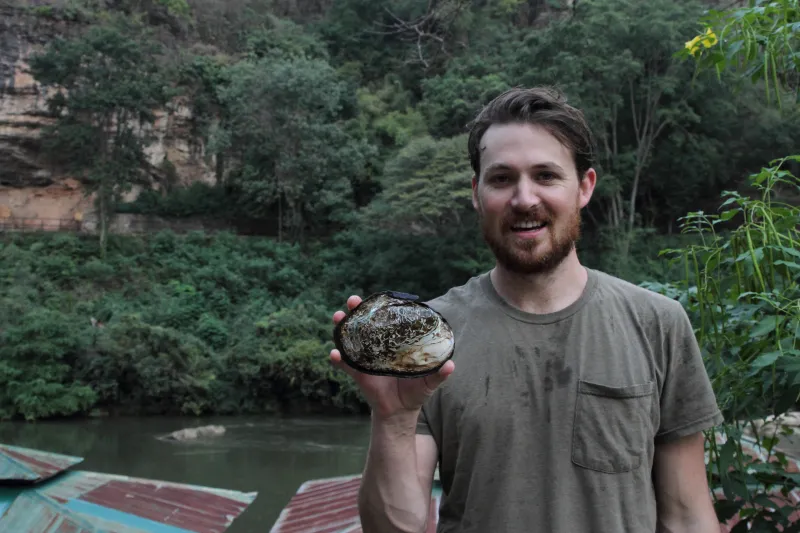
Search

New Curators for Invertebrate Zoology
Written by Jaimee-Ian Rodriguez and Raven Benko

John Pfeiffer first forayed into natural history collections work during his undergrad at Northern Michigan University. At the time, he was unaware that his professional journey would lead to a position as the new Curator of Bivalves at the Smithsonian National Museum of Natural History. As an ambitious undergraduate at a small university nestled on the south shore of Lake Superior, Pfeiffer developed his fascination with freshwater mussels and decided to take a stab at collections-based research. With specimen donations from the Illinois Natural History Survey and his own local collecting efforts, Pfeiffer built the school’s first collection of freshwater mussels, focused on species distributed across the Midwestern United States. Today, the school still proudly displays the exhibit Pfeiffer built to document the freshwater mussel diversity in the region.
During his time at the University of Alabama as a master’s student, Pfeiffer was more completely introduced to biodiversity science and investigated the evolutionary history of lesser-known freshwater mussel species in Southeast Asia, primarily in Thailand. As part of his master’s research Pfeiffer discovered that an endemic radiation of mussels in southeast Asia had evolved an unusual adaptation that caused the parasitic larvae to have asymmetrical shells. Pfeiffer continued his research on tropical freshwater mussels during his Ph.D. at the University of Florida and the Florida Museum of Natural history. There, he worked to uncover the evolutionary history of species in Mesoamerica and Southeast Asia. The species-level diversity between temperate and tropical freshwater mussels is comparable but lack the same level of documentation as to their North American counterparts. Eliminating this disparity is one of Pfeiffer’s main goals.
While the evolution of mussels lured Pfeiffer into his current research, he now also dedicates much of his work to conservation. “A lot of my conservation work,” he says, “has to do with understanding species boundaries. In order to protect a critter, you have to understand where it’s found, how that range has changed over time, and how you might expect it to change in the future due to certain threats.” As a newly appointed Smithsonian researcher, Pfeiffer hopes to reveal some secrets about the many mussel species housed here at the National Museum of Natural History. The Department of Invertebrate Zoology could not be more excited to have him on board.

The Department of Invertebrate Zoology continues to bolster their reputation with the arrival of impressive, young researchers. The latest expert to board this ship of scientists is the new curator of anthozoans, Andrea Quattrini. Quattrini’s career began surrounded by farms and creeks as she pursued her bachelor’s at Millersville University in her home state of Pennsylvania. From there, she carried her ambitions to the University of North Carolina, Wilmington to obtain a master’s degree, for which she researched larval fish distributions. Fortunately for the world of IZ, the master’s-equipped Quattrini stayed at UNC to study how fishes associate with coral habitats in the deep sea. For six years she worked as a research technician with this lab and, by the end of it, Quattrini knew she wanted to pursue a career investigating deep-sea corals. Corals drew her in further because of their ability to survive subsampling, the complex ecosystems they can form, and the stories these ancient organisms tell us about our planet.
Over the course of her career, Quattrini blazed trails in genetics. She began in her doctoral years with genetic work on octocorals. Most recently, though, she demonstrated her expertise with an ambitious postdoctoral project at Harvey Mudd College. There, she worked to create a robust evolutionary tree of anthozoans - from soft corals to stony corals to anemones. Several agencies have recruited Quattrini because of her concern for human impact. NOAA, for example, funds her to identify vulnerable habitats using her genetic tools. Quattrini aids in the NOAA Restore Act by examining ecosystems in the Gulf of Mexico, how they have responded to the Deepwater Horizon spill, and how they might respond in the future. Another NOAA project has Quattrini inform them of the species interactions throughout the Gulf in an effort to expand boundaries for the Flower Garden Banks National Marine Sanctuary. These projects set the tone for Quattrini’s character; she is not only a talented geneticist, she wants to take action.
The museum setting is new for Quattrini, but she delights in it. Reveling in her chance to meet all types of guests, she says, “hands on experience is really important for education, and what I love about this place is that I can engage with the public as much as I want!” She especially looks forward to interacting with kids, who she hopes will grow up appreciating the natural wonders. “Go to the beach, go camping,” she advises, “just take a moment and enjoy this world."